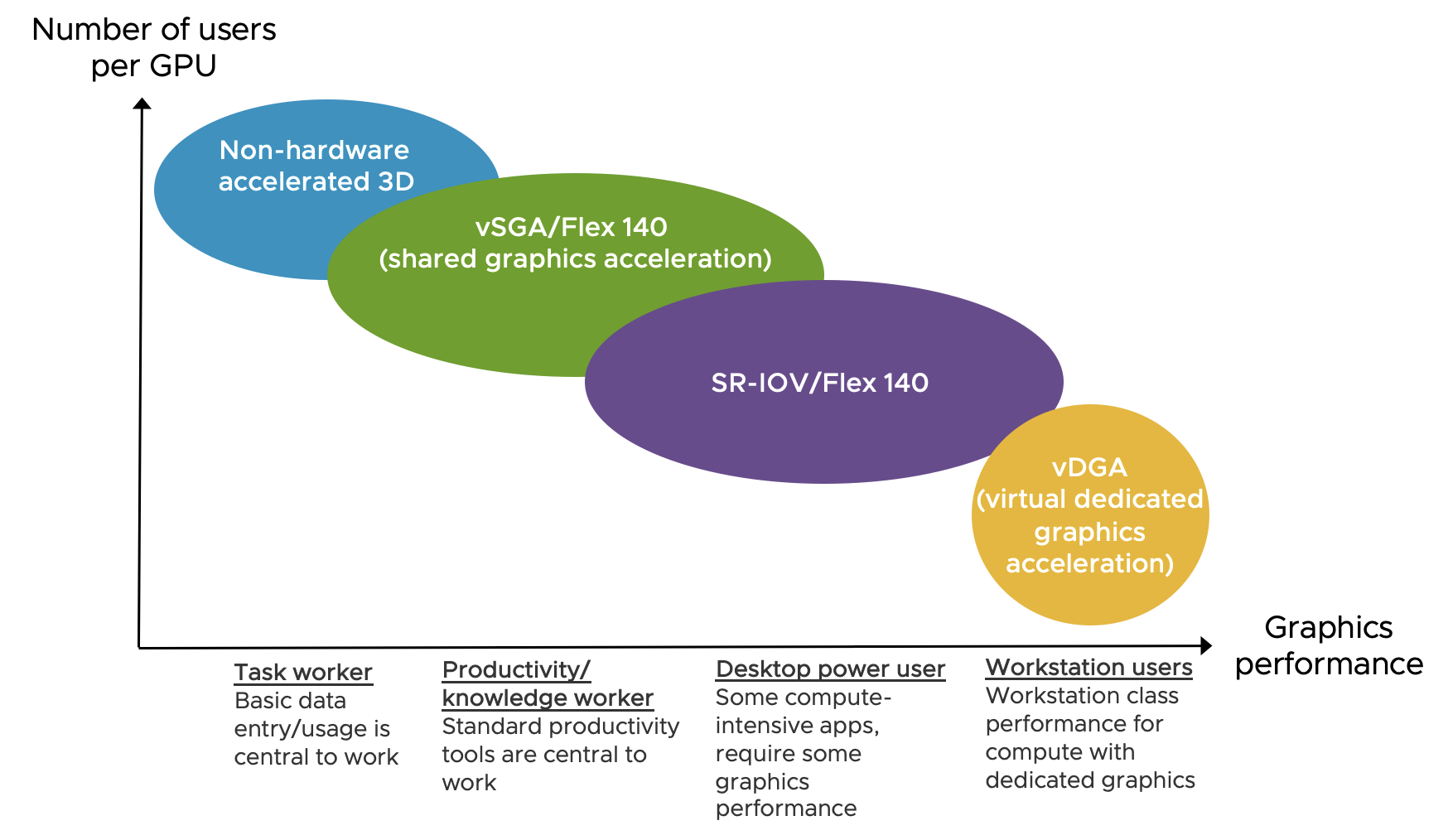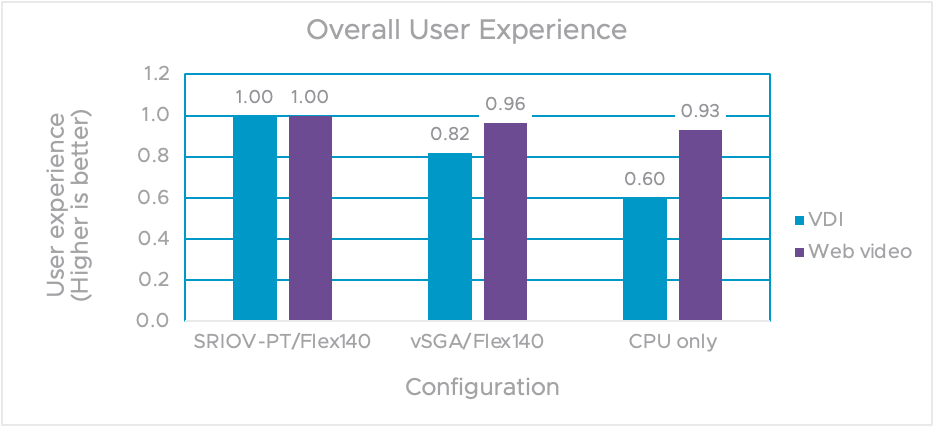An increasing number of remote workers has made virtual desktop infrastructure (VDI) software like Omnissa Horizon essential for businesses. VMware vSGA, a feature of VMware vSphere and VMware Cloud Foundation, addresses this need by allowing multiple virtual desktops to share a single graphics processing unit (GPU). This sharing of resources accelerates 3D graphics applications in Windows and Linux VMs and reduces a company’s total cost of ownership (TCO). For example, instead of the 12 VMs possible with an SR-IOV/passthrough solution, a single GPU could support 24 VMs running graphics workloads.
We tested the performance of vSGA with Intel Data Center GPU Flex Series to prove that this combination is robust enough to accelerate low-to-moderate graphics processing workloads running in a virtualized environment.
Our testbed included a Windows 11 Enterprise VM on a 2-socket Dell R650 server with 2 Intel Data Center GPU Flex 140 graphics cards. The server ran vSphere 8.0 U3.
We report our findings in the technical white paper, Improving VDI Workload Consolidation with VMware vSGA and Intel Data Center GPU Flex Series.
Use cases
vSGA use cases involve knowledge workers using various non-specialized end-user applications that don’t require complex models to render. The paper shows the performance results for the following use cases:
- VDI
- Web video
- Web graphics library (WebGL) benchmarks
- CAD viewers
Figure 1 shows where our tested configurations for the use cases sit in relation to a virtual dedicated graphics acceleration (vDGA) solution. The configurations shown in the figure include:
- Non-hardware accelerated 3D: Uses the physical CPU in the ESXi host
- vSGA/Flex 140: Shares a GPU on the ESXi host among any of its VMs
- SR-IOV/Flex 140: Uses passthrough to allow direct access to the GPU and allows VMs to share it
- vDGA (not tested): Provides direct passthrough to a GPU on the ESXi host; gives a user unrestricted, dedicated access to a single GPU

The vertical axis shows the different use cases that can utilize more shared GPUs. The horizontal axis shows an increasing amount of graphics performance. It also shows where different use cases benefit most along the continuum.
Advantages of vSGA
vSGA results in enhanced management, streamlined consolidation, and workload efficiency. Because it is a feature of vSphere, you can:
- Enjoy lower TCO with 2x the consolidation of VMs on an ESXi host with vSphere/vSGA vs SR-IOV/passthrough.
- Share a single graphics card among multiple VMs with vSphere’s ability to consolidate VMs on a single ESXi host and dynamically grow or shrink the number of VMs per host (elasticity).
- Accelerate hardware for VMs with different performance requirements on a single GPU.
- Suspend and resume VMs.
- Migrate VMs using vMotion.
- Ensure compatibility between the guest operating system and ESXi host driver across vSphere versions.
- Use vSphere DRS for the initial placement of VMs and load-balancing.
User experience measurement
We measured the user experience on three configurations, as shown in figure 2:
- CPU only: CPU-only 3D graphics
- vSGA/Flex140: 3D graphics support using vSGA on Flex 140
- SRIOV-PT/Flex140: 3D graphics support using SR-IOV with passthrough to Flex 140
The overall user experience was between 0.0 and 1.0, with 1.0 being the highest score.

Featured hardware and software
Intel Data Center GPU Flex Series supports a visually rich graphical experience for VDI. The GPU Flex Series delivers a highly performant, dependable, scalable VDI solution for today’s knowledge worker.
Omnissa Horizon 8 supports vSGA and extends that to Intel GPUs, allowing organizations to leverage Intel’s hardware when running virtual desktops and applications on vSphere and VCF. Using the Blast delivery protocol, Horizon provides an exceptional user experience, especially for those working with intensive graphics applications. Together, the solutions deliver faster graphics processing that helps users benefit from smooth, high-quality visuals.
Conclusion
Our technical paper demonstrates that the combination of VMware vSGA and Intel Data Center GPU Flex Series delivers a good solution for accelerating graphics processing workloads in a virtualized environment. This solution offers significant advantages, including enhanced management, streamlined consolidation, workload efficiency, and improved user experience. By leveraging the capabilities of vSGA and the performance of Intel GPUs, organizations can optimize their VDI deployments, reduce TCO, and provide their users with a seamless and productive experience. We recommend vSGA based on its overall performance and the availability of vSphere virtualization features for the workloads we tested.
Discover more from VMware Cloud Foundation (VCF) Blog
Subscribe to get the latest posts sent to your email.
